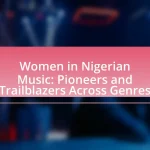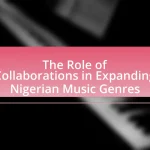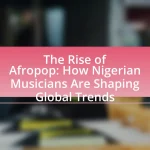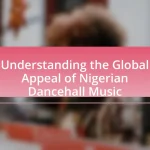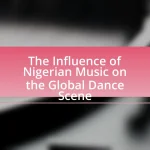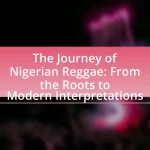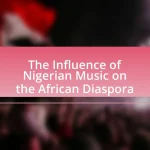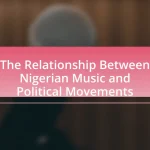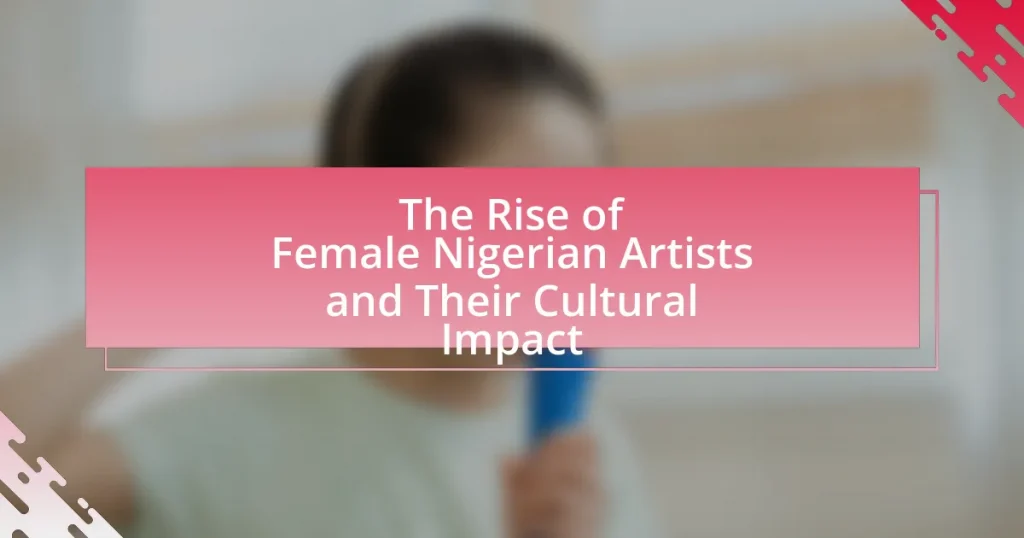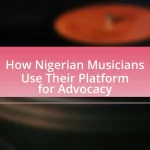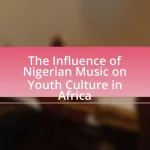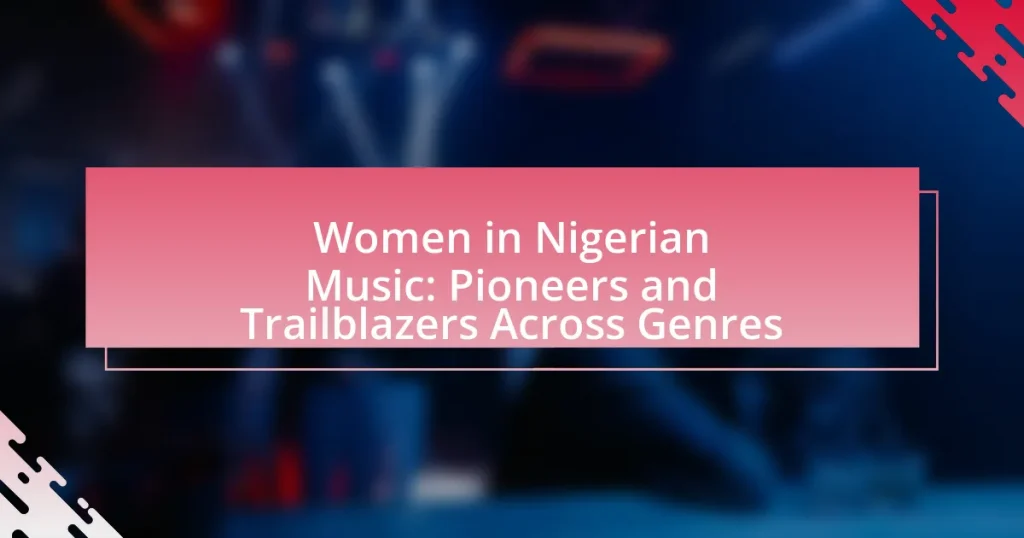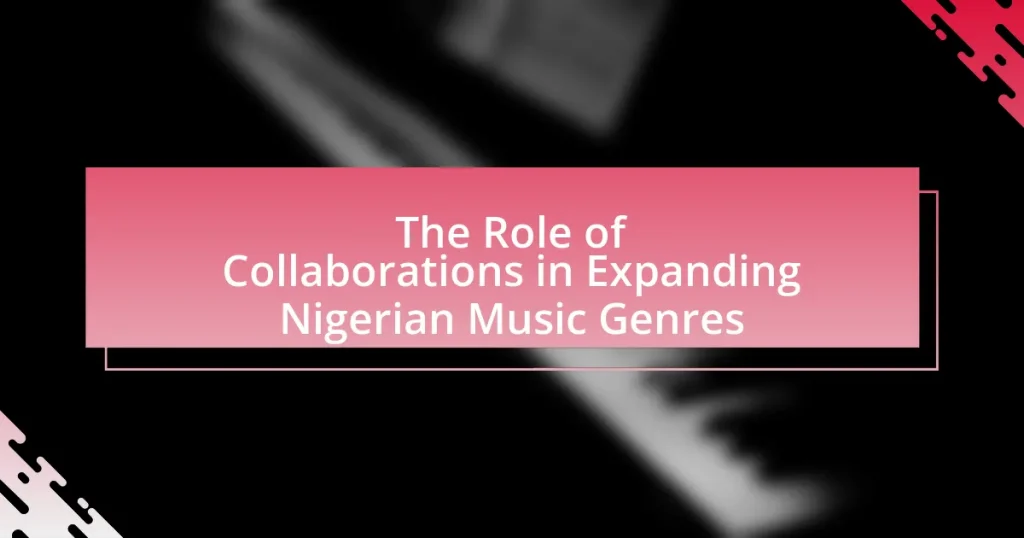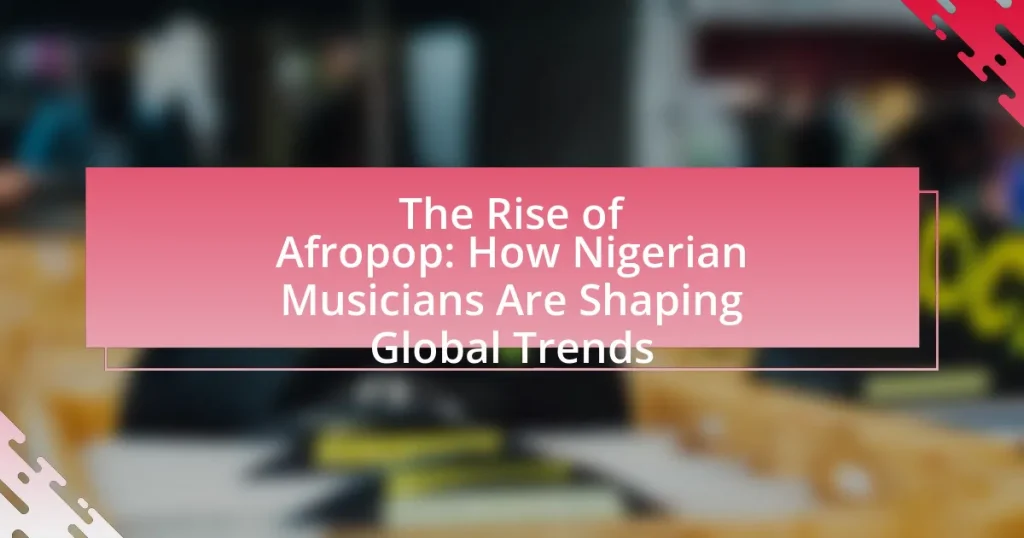The article examines the rise of female Nigerian artists and their significant cultural impact in contemporary society. It highlights how these artists challenge societal norms, promote gender equality, and influence cultural narratives through various artistic mediums, including music and visual arts. Key figures such as Tiwa Savage and Yemi Alade are discussed for their international recognition and contributions to themes of empowerment and social justice. The article also explores historical factors, societal changes, and the challenges faced by female artists, while emphasizing the importance of community support and initiatives aimed at fostering their success in the arts.
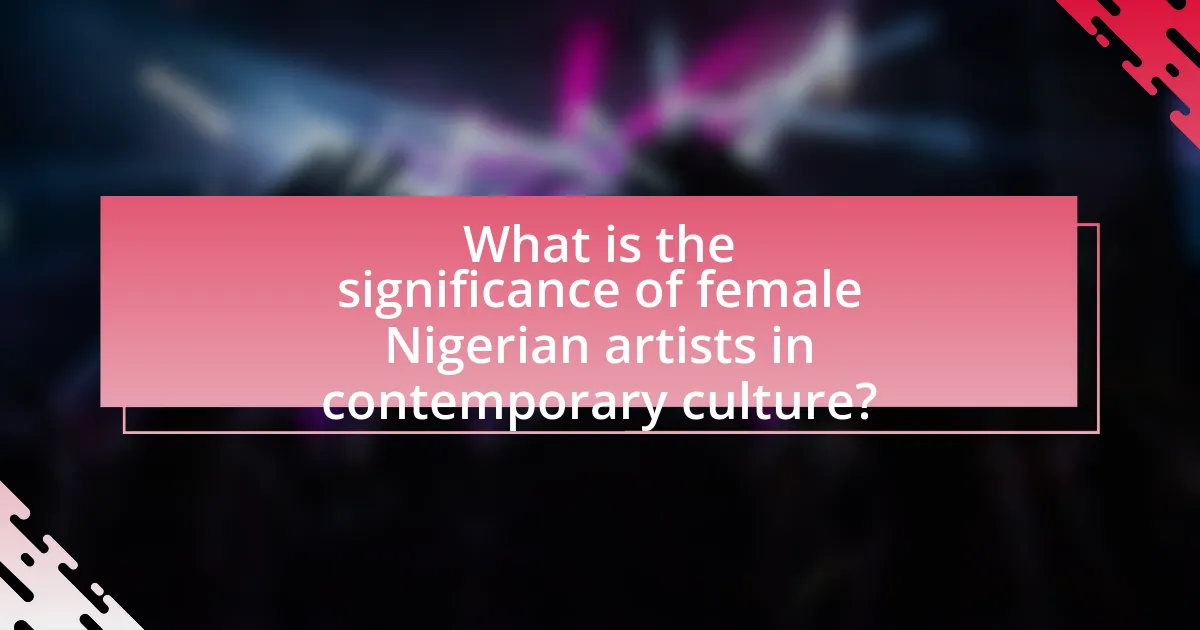
What is the significance of female Nigerian artists in contemporary culture?
Female Nigerian artists play a crucial role in contemporary culture by challenging societal norms and promoting gender equality through their work. They use various artistic mediums, including music, visual arts, and literature, to express their perspectives and experiences, thereby influencing cultural narratives. For instance, artists like Tiwa Savage and Yemi Alade have gained international recognition, showcasing African culture and addressing issues such as women’s empowerment and social justice. Their contributions not only enrich the cultural landscape but also inspire a new generation of female creatives, fostering a more inclusive and diverse artistic community in Nigeria and beyond.
How have female Nigerian artists emerged in the music and art scenes?
Female Nigerian artists have emerged prominently in the music and art scenes through a combination of cultural shifts, increased visibility, and support from digital platforms. The rise of social media and streaming services has allowed these artists to reach wider audiences, bypassing traditional gatekeepers in the industry. For instance, artists like Tiwa Savage and Yemi Alade have gained international recognition, with Tiwa Savage being the first female Nigerian artist to sign with Universal Music Group in 2016. Additionally, the Nigerian art scene has seen significant contributions from female artists such as Njideka Akunyili Crosby, whose work has been exhibited globally and reflects contemporary Nigerian culture. This emergence is further supported by initiatives aimed at empowering women in the arts, such as the Women in Music initiative, which fosters collaboration and mentorship among female artists.
What historical factors contributed to the rise of female Nigerian artists?
The rise of female Nigerian artists has been significantly influenced by historical factors such as the feminist movements, increased access to education, and the impact of globalization. The feminist movements in Nigeria, particularly from the 1980s onward, advocated for women’s rights and empowerment, creating a conducive environment for female artists to express themselves. Increased access to education, especially in the arts, allowed women to develop their skills and gain recognition in a traditionally male-dominated field. Additionally, globalization facilitated exposure to international art scenes, enabling female Nigerian artists to showcase their work globally and connect with broader audiences. These factors collectively contributed to the emergence and recognition of female artists in Nigeria.
How have societal changes influenced the visibility of female artists in Nigeria?
Societal changes in Nigeria have significantly increased the visibility of female artists by challenging traditional gender roles and promoting gender equality. The rise of feminist movements and advocacy for women’s rights has led to greater acceptance and support for female creativity in various art forms, including music, visual arts, and literature. For instance, the Nigerian music industry has seen a surge in female artists like Tiwa Savage and Yemi Alade, who have gained international recognition, reflecting a shift in societal attitudes towards women in the arts. Additionally, initiatives such as the “Women in Music” program have provided platforms for female artists to showcase their work, further enhancing their visibility and influence in the cultural landscape.
What roles do female Nigerian artists play in cultural representation?
Female Nigerian artists play crucial roles in cultural representation by challenging stereotypes, preserving traditions, and promoting social issues through their work. They utilize various art forms, including music, visual arts, and literature, to express the complexities of Nigerian identity and culture. For instance, artists like Tiwa Savage and Yemi Alade incorporate traditional Nigerian sounds and themes into contemporary music, thereby bridging generational gaps and fostering cultural pride. Additionally, visual artists such as Njideka Akunyili Crosby address themes of diaspora and identity, reflecting the multifaceted experiences of Nigerians both at home and abroad. This engagement not only enriches the cultural landscape but also empowers women by providing platforms for their voices and perspectives, thus contributing to a more inclusive representation of Nigerian culture.
How do these artists challenge traditional gender roles through their work?
Female Nigerian artists challenge traditional gender roles through their work by subverting societal expectations and redefining femininity. For instance, artists like Njideka Akunyili Crosby and Peju Alatise incorporate themes of identity, empowerment, and cultural heritage in their art, which often critiques patriarchal norms. Their use of mixed media and personal narratives allows them to express complex female experiences, thereby promoting a broader understanding of gender roles. This approach is evident in Akunyili Crosby’s works that blend traditional Nigerian motifs with contemporary issues, illustrating the duality of her identity as a Nigerian woman in a global context. Alatise’s sculptures often depict strong female figures, challenging the stereotype of women as passive subjects. Through these artistic expressions, they not only highlight the struggles faced by women but also celebrate their resilience and agency, effectively reshaping perceptions of gender in Nigerian society.
What themes are prevalent in the works of female Nigerian artists?
Female Nigerian artists frequently explore themes of identity, gender, and social justice in their works. These themes reflect the complexities of Nigerian society and the unique experiences of women within it. For instance, artists like Njideka Akunyili Crosby address issues of cultural hybridity and the intersection of traditional and contemporary identities, while others, such as Peju Alatise, focus on gender roles and the empowerment of women. The prevalence of these themes is supported by the growing recognition of female artists in exhibitions and art fairs, highlighting their contributions to discussions on societal change and cultural representation.
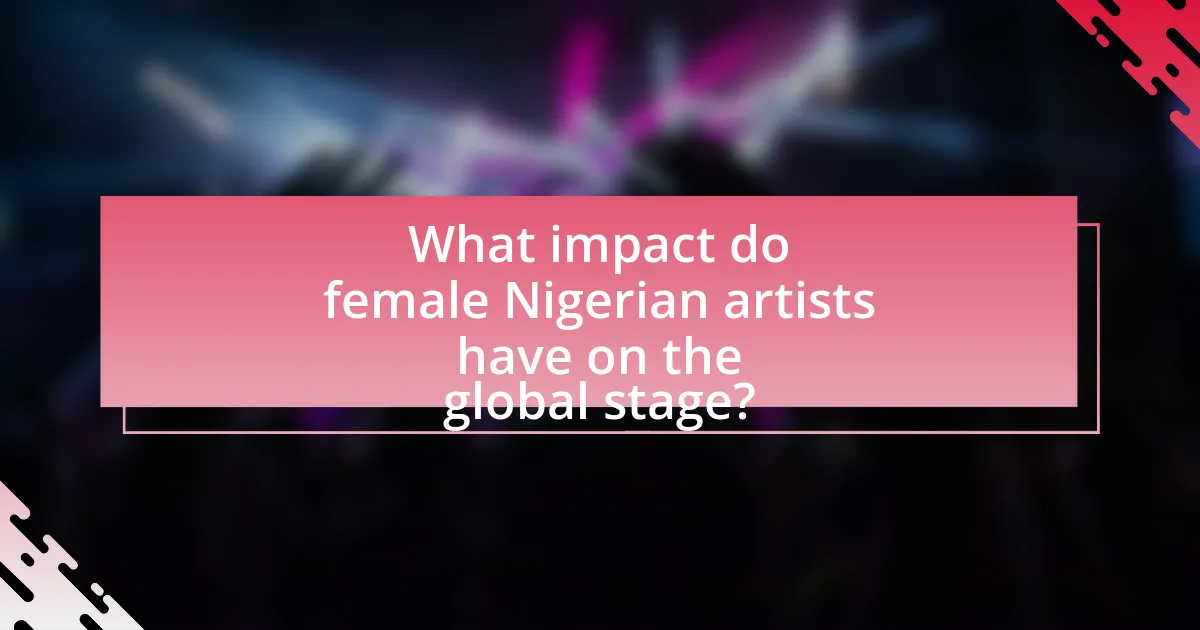
What impact do female Nigerian artists have on the global stage?
Female Nigerian artists significantly influence the global stage by promoting African culture and music, thereby reshaping perceptions of Nigeria and Africa as a whole. Artists like Burna Boy, Tiwa Savage, and Yemi Alade have gained international recognition, with Tiwa Savage being the first female Nigerian artist to sign with Universal Music Group in 2019, which highlights the increasing visibility of female talent. Their collaborations with global artists, such as Beyoncé’s “Brown Skin Girl,” showcase the fusion of African sounds with mainstream music, further enhancing cultural exchange. The global success of these artists has led to increased interest in Afrobeat and Nigerian culture, evidenced by the genre’s rise on international music charts and festivals.
How are female Nigerian artists influencing international music and art trends?
Female Nigerian artists are significantly influencing international music and art trends through their unique fusion of traditional African sounds with contemporary genres. Artists like Burna Boy, Tiwa Savage, and Yemi Alade have gained global recognition, showcasing Afrobeat and Afropop on international platforms such as the Grammy Awards and major music festivals. This exposure has led to a growing interest in African culture and music, prompting collaborations with international artists and the incorporation of African rhythms into mainstream music. For instance, Burna Boy’s album “African Giant” received a Grammy nomination, highlighting the global appeal of Nigerian music. Additionally, female visual artists like Njideka Akunyili Crosby and Peju Alatise are redefining contemporary art by blending Nigerian cultural motifs with global artistic practices, thus influencing international art trends and conversations around identity and representation.
What collaborations have female Nigerian artists engaged in with international artists?
Female Nigerian artists have engaged in numerous collaborations with international artists, significantly enhancing their global presence. Notable examples include Tiwa Savage’s collaboration with American artist Omarion on the track “Get It Now,” and Yemi Alade’s partnership with French singer Dadju on “Don’t Jealous Me.” Additionally, Burna Boy’s collaboration with Beyoncé on “Brown Skin Girl,” which features Nigerian artist Wizkid, showcases the intersection of Nigerian talent with global music icons. These collaborations not only highlight the artistic synergy but also contribute to the growing recognition of Nigerian music on the world stage.
How do female Nigerian artists represent African culture to a global audience?
Female Nigerian artists represent African culture to a global audience through their music, visual arts, and storytelling, which often incorporate traditional themes, languages, and contemporary issues. For instance, artists like Tiwa Savage and Yemi Alade blend Afrobeat with global pop influences, showcasing Nigerian rhythms and cultural narratives while addressing themes such as empowerment and identity. Additionally, visual artists like Njideka Akunyili Crosby utilize mixed media to reflect African heritage and personal experiences, gaining international recognition and sparking conversations about cultural representation. This fusion of traditional and modern elements not only preserves African culture but also makes it accessible and relatable to a diverse audience worldwide.
What recognition have female Nigerian artists received internationally?
Female Nigerian artists have received significant international recognition, exemplified by awards and global collaborations. Notable achievements include Burna Boy’s Grammy Award for Best World Music Album in 2020, which highlighted the contributions of Nigerian artists, including female musicians like Tiwa Savage and Yemi Alade, who have also garnered nominations and performed on international stages. Additionally, artists such as Simi and Tems have gained international acclaim, with Tems winning a Grammy for her collaboration on Wizkid’s “Essence.” These recognitions underscore the growing influence and visibility of female Nigerian artists in the global music industry.
Which awards and accolades have been significant for female Nigerian artists?
Significant awards and accolades for female Nigerian artists include the Headies Awards, the Nigeria Entertainment Awards, and the International Women’s Music Summit. The Headies Awards, established in 2006, recognize outstanding achievements in the Nigerian music industry, with categories specifically honoring female artists. The Nigeria Entertainment Awards, launched in 2006, also celebrate the contributions of female musicians, providing a platform for recognition and visibility. Additionally, the International Women’s Music Summit, which focuses on empowering women in music globally, has featured Nigerian artists, highlighting their influence and contributions to the industry. These awards not only acknowledge talent but also promote gender equality and representation in the Nigerian music scene.
How do these recognitions affect their careers and the perception of Nigerian art?
Recognitions significantly enhance the careers of female Nigerian artists and positively influence the perception of Nigerian art. These accolades often lead to increased visibility, opportunities for exhibitions, and access to international markets, which can elevate an artist’s profile and financial stability. For instance, awards such as the Art X Prize and participation in global art fairs have showcased the talents of female Nigerian artists, resulting in greater appreciation and demand for their work. This recognition not only validates their contributions but also challenges stereotypes about Nigerian art, fostering a broader understanding and appreciation of its diversity and richness.
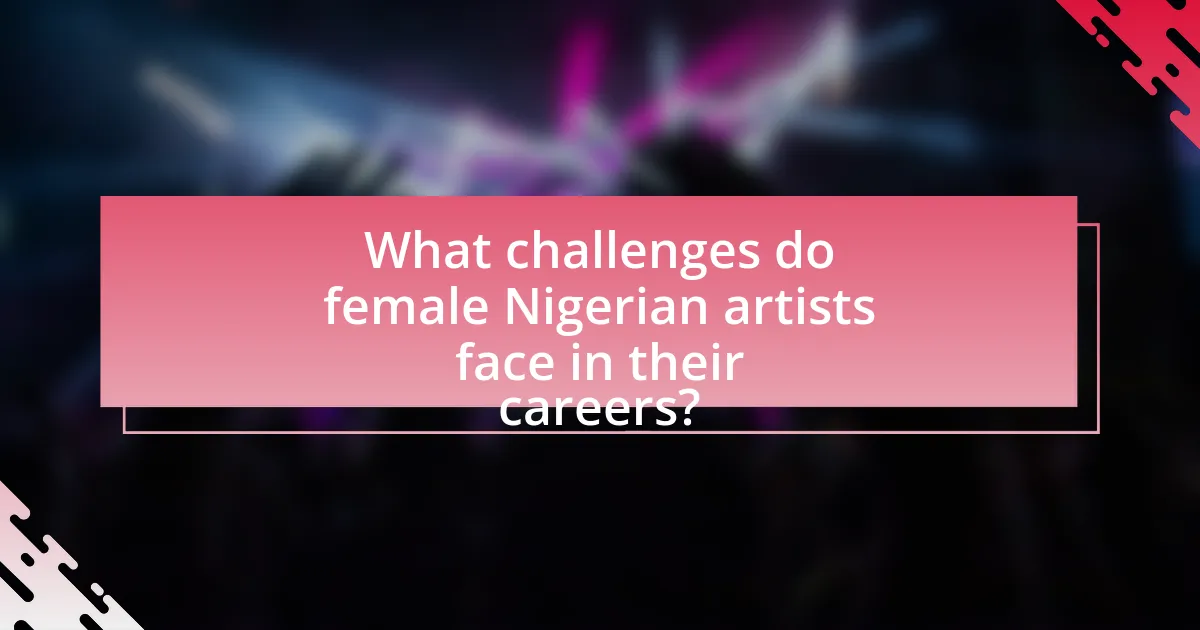
What challenges do female Nigerian artists face in their careers?
Female Nigerian artists face significant challenges in their careers, including gender discrimination, limited access to funding, and societal expectations. Gender discrimination manifests in the music and art industries, where female artists often receive less recognition and fewer opportunities compared to their male counterparts. Limited access to funding is a critical barrier, as many female artists struggle to secure financial support for their projects, which hampers their ability to produce and promote their work. Societal expectations further complicate their careers, as traditional gender roles can restrict their creative expression and professional ambitions. These challenges are documented in various studies, highlighting the systemic issues that female artists navigate in Nigeria’s cultural landscape.
How do societal expectations impact the careers of female Nigerian artists?
Societal expectations significantly impact the careers of female Nigerian artists by imposing traditional gender roles that often limit their creative expression and professional opportunities. These expectations can lead to challenges such as societal pressure to conform to domestic responsibilities, which may hinder their ability to pursue artistic careers fully. For instance, many female artists face scrutiny regarding their choices in music genres or performance styles, as society often expects them to adhere to culturally defined roles. Research indicates that female artists in Nigeria frequently navigate a landscape where their work is undervalued compared to their male counterparts, affecting their visibility and marketability. This dynamic is evident in the music industry, where female artists often have to work harder to gain recognition and respect, as highlighted by the success of artists like Tiwa Savage and Yemi Alade, who have had to challenge these societal norms to achieve prominence.
What barriers do female artists encounter in the Nigerian music and art industries?
Female artists in the Nigerian music and art industries encounter significant barriers, including gender discrimination, limited access to funding, and societal expectations. Gender discrimination manifests in the form of unequal opportunities for performances and recognition compared to their male counterparts, often leading to fewer female-led projects. Limited access to funding is a critical issue, as many female artists struggle to secure financial backing for their work, which is essential for production and promotion. Societal expectations further complicate their careers, as traditional gender roles often dictate that women prioritize family responsibilities over professional aspirations. According to a 2021 report by the British Council, only 30% of women in Nigeria’s creative sector receive funding compared to 70% of men, highlighting the financial disparities that female artists face.
How do issues of funding and support affect female Nigerian artists?
Issues of funding and support significantly hinder the progress of female Nigerian artists by limiting their access to resources necessary for artistic development and exposure. Female artists often face systemic barriers that restrict their ability to secure financial backing, which is crucial for producing and promoting their work. For instance, a study by the African Women in Arts Network highlights that only 30% of funding opportunities in Nigeria are accessible to women, reflecting a gender disparity in the arts sector. This lack of financial support not only affects their ability to create but also diminishes their visibility in a competitive market, ultimately impacting their cultural contributions and representation in the arts.
What strategies do female Nigerian artists use to overcome these challenges?
Female Nigerian artists employ various strategies to overcome challenges such as gender bias, limited access to resources, and societal expectations. They often collaborate with other artists and organizations to create supportive networks that enhance visibility and provide mentorship opportunities. Additionally, many utilize social media platforms to showcase their work, engage with audiences, and build personal brands, which helps them reach wider audiences and gain recognition. For instance, artists like Tems and Simi have effectively used platforms like Instagram and Twitter to promote their music and connect with fans, thereby circumventing traditional industry barriers. These strategies not only empower individual artists but also contribute to a collective movement that challenges the status quo in the Nigerian music and art scenes.
How do networking and community support play a role in their success?
Networking and community support are crucial for the success of female Nigerian artists as they provide access to resources, collaboration opportunities, and visibility. These artists often leverage social media platforms and local networks to connect with peers, industry professionals, and audiences, which enhances their reach and influence. For instance, initiatives like the “Women in Music” movement in Nigeria foster collaboration among female artists, enabling them to share experiences and promote each other’s work. This collective effort not only amplifies their voices but also creates a supportive environment that encourages creativity and resilience, ultimately contributing to their cultural impact and commercial success.
What initiatives exist to promote and support female Nigerian artists?
Several initiatives exist to promote and support female Nigerian artists, including the Women in Music Nigeria (WIMN) organization, which focuses on empowering women in the music industry through mentorship and networking opportunities. Additionally, the Art Twenty One initiative provides a platform for female visual artists to showcase their work and gain visibility in the art community. The Lagos Fashion Week also features female designers prominently, promoting their brands and creativity. These initiatives are crucial in addressing gender disparities in the arts and fostering a supportive environment for female talent in Nigeria.
What can aspiring female artists learn from the experiences of established Nigerian artists?
Aspiring female artists can learn resilience and the importance of cultural authenticity from the experiences of established Nigerian artists. Many successful Nigerian female artists, such as Tiwa Savage and Yemi Alade, have faced significant challenges, including gender bias and industry skepticism, yet they have persevered by staying true to their cultural roots and expressing their unique identities through their art. For instance, Tiwa Savage’s blend of Afrobeat with contemporary pop has not only garnered international acclaim but also highlighted the richness of Nigerian culture, demonstrating that authenticity can resonate with a global audience. This approach encourages aspiring artists to embrace their heritage while navigating the complexities of the music industry.
